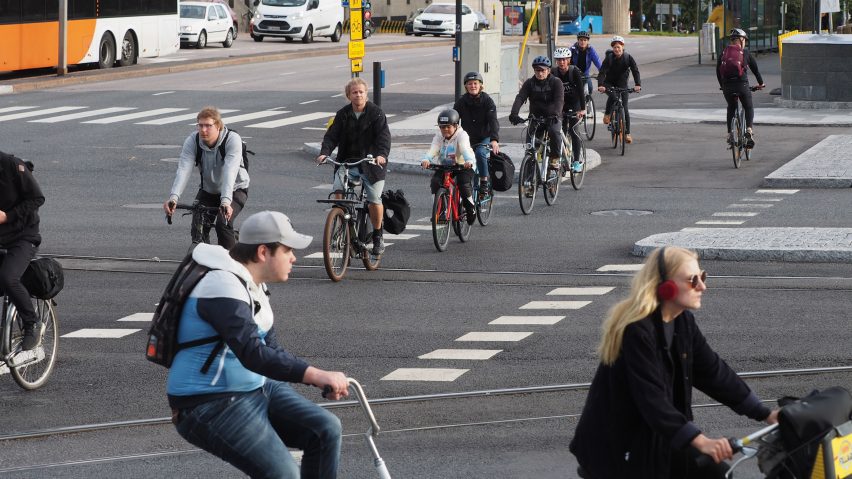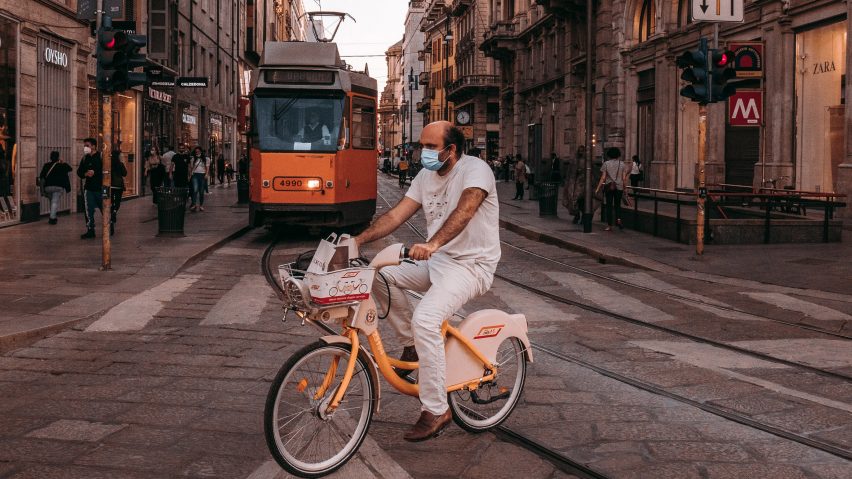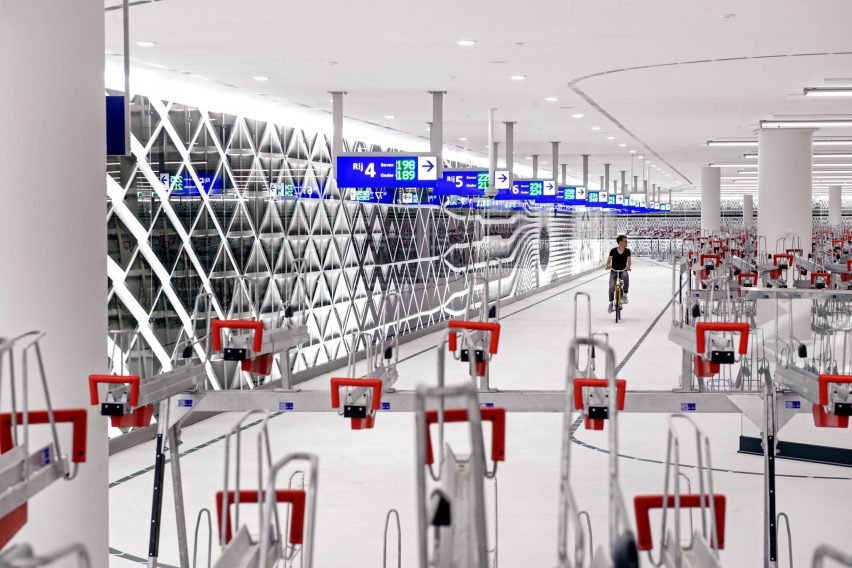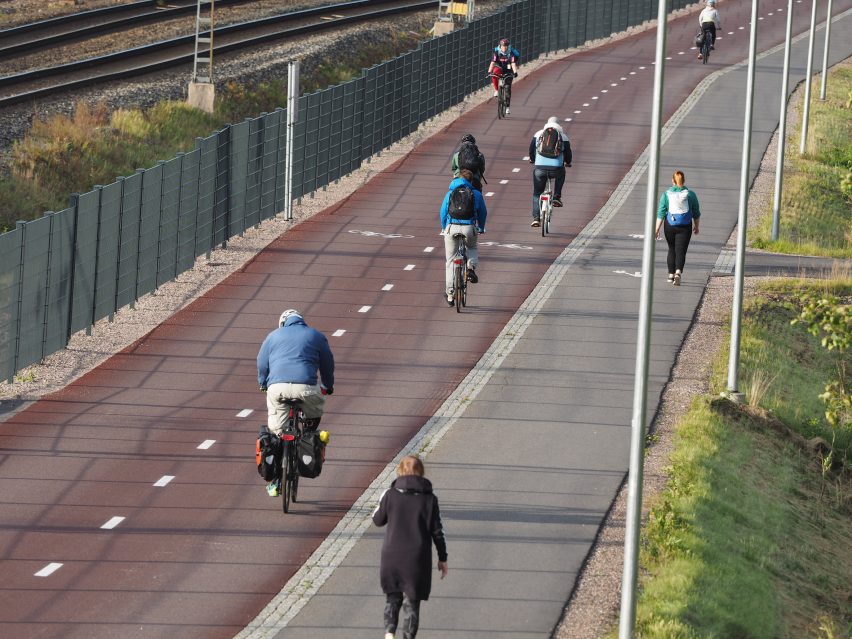
Global cities becoming cycle friendly after "seismic shift" during pandemic
With the coronavirus pandemic forcing a rethink of our urban centres, Dezeen spoke to experts about how municipalities around the world are striving to become "magical" cycling cities.
Cycling is now a major global trend, with several city governments announcing bold ambitions to swap cars for bikes, particularly in Europe but also beyond.
"I would say that in the past two years there has been a seismic shift," said Will Butler-Adams, CEO of folding bicycle manufacturer Brompton. "One thing that Covid did deliver to the world was a reflection on how we want to live in our cities," he told Dezeen.
"We have the solution"
In October, Paris revealed a plan to become a "100 per cent cyclable city" by 2026. Milan wants to build even more cycle lanes than the French capital over the next 15 years. Berlin intends to create a car-free area larger than Manhattan.
The EU is considering proposals to require 424 cities across the continent to develop "sustainable urban mobility plans" prioritising cycling and walking by 2025.
Austin, Texas, voted in November for a new tax that will raise $480 million for active travel projects. Montréal accelerated its programme for a new 184km express bike network, the Réseau express vélo, during the pandemic.
While the pandemic forced many to evaluate their physical health – and reminded governments of the financial cost associated with an unhealthy population – lockdowns offered an opportunity to reconsider our city spaces.

Meanwhile, the increasing urgency of the climate crisis is galvanising a move away from the polluting, resource-hungry car.
"We don't need to do anything radical; we don't need flying cars," Butler-Adams added. "We have the solution. We just forgot about it."
Cycling "has the potential to simultaneously serve many challenges"
Significantly boosting cycling has multiple potential benefits for cities: reducing carbon emissions, making people healthier, reducing congestion, improving road safety and freeing up space currently dominated by cars.
"Whether it's health, climate, social justice, the economy or air quality, these are all things cycling can aid," said Dr Meredith Glaser, director at the Urban Cycling Institute in Amsterdam.
"I think that's a really unique aspect of bicycling in cities: it has the potential to simultaneously serve many challenges and it seems that cities have sort of leaned into one or a couple in particular."
So how do you transform a throbbing, traffic-clogged metropolis into a cycle city?
"You've probably heard the age-old adage that the three rules of real estate are location, location, location," explained Michael Wexler, Montréal director of cycling consultancy Copenhagenize Design Co. "For urban cycling, I would say the three rules are infrastructure, infrastructure, infrastructure."
In the main, that means bicycle lanes designed to best-practice standards – unidirectional, with road space taken away from cars to make room and a physical barrier protecting cyclists from vehicles.
Wexler subscribes to the "build it and they will come" philosophy. "It's very understandable that folks in central LA aren't going to be riding around until LA builds protected bike lanes," he said.
He cites the example of Seville, which built 80 kilometres of fairly basic protected cycle lanes in a matter of months in 2020 and almost immediately saw a seven per cent jump in the proportion of journeys taken by bike.
"It's not necessarily lots of bicycle infrastructure"
Other types of infrastructure are also important and are where good design is vital. The Netherlands is leading the way in bicycle parks, such as the Dezeen Award-winning garage in The Hague by Silo.
Then there is Cyclehoop, a London-based firm that builds secure hangars for multiple bikes with a footprint the size of a car parking space. Malmö has developed a sensor system to alert drivers when cyclists are approaching at junctions.
"It's really just taking what we've done so unfortunately well for cars and applying it to bikes," summarised Wexler.
The principle is simple, but the complexity is in establishing how this infrastructure should fit into the existing city.
"There's no point reinventing the wheel; we already know what works, what needs to be done," said Oskari Kaupinmäki, a cycling coordinator and urban transportation expert in the City of Helsinki's Urban Environment Division.
"It's not necessarily lots of bicycle infrastructure, it's putting bicycle infrastructure where it's needed."

Similar to many other cities, Helsinki is currently working on a fast-tracked Bicycle Action Plan, with an aim to increase the proportion of journeys taken by bike from its current level of around 11 per cent to 15 per cent by 2025 and at least 20 per cent by 2035.
Achieving that goal, it estimates, will reduce the city's carbon emissions by two per cent.
"We are going to become sort of like a Copenhagen with trams in about 10 years," Kaupinmäki told Dezeen.
"We are transforming Helsinki from a relatively car-oriented city into a human-friendly city. It's not that we're putting the bicycle on a pedestal and putting it over everything else. We're just treating it equally."
That is what Wexler refers to as the crucial "paradigm shift from the car-centric plan to more people-centric planning".
"It's putting the community, the person, at the heart of town planning," echoed Butler-Adams. "For 50 years or longer, the automobile has been right at the heart."
Helsinki already has the advantage of a world-leading public transit network, making it easier for the city to create "multimodal" options – such as cycling to a tram stop – appealing enough to disincentivise driving.
At the crux of the Finnish capital's plan is the construction of 130 kilometres of best-practice cycle infrastructure.
It currently has around 1,300 kilometres of cycleways – double that of Copenhagen – but apart from a 50 kilometre sliver, these are poor quality, based on a 1960s model that sees cyclists mixed with pedestrians on single paths. Kaupinmäki describes this approach as "terrible" for both those on foot and on bikes.
Before Kaupinmäki and his team could decide where this new infrastructure should go, they had to consider the city as a whole and how they want people to move through it.
"It really comes down to the comprehensive approach. So before you even think about cycling, you've got to look at the city map on a transport network level," he explained. "You've got to recognise the main arteries for car traffic, which are also usually main arteries for public transit, and then recognise all the local areas between those arteries."
These arterial roads, vital to the flow of traffic through the city, are where cars are funnelled and protected bike lanes come in.
"You can turn London, Paris, LA, San Francisco, Seoul into magical cities"
Elsewhere, in the neighbourhood streets, robust traffic calming measures are being used to enable even inexperienced cyclists to ride comfortably alongside cars.
This approach, which Kaupinmäki defines as "mix if you can, separate if you must", is set out in the widely influential Dutch Design Manual for Bicycle Traffic published by non-profit agency CROW.
In the UK, car-pacifying areas which block off through-roads are called "Low-Traffic Neighbourhoods" (LTNs). In Germany, they are known as Kiezblocks.
According to Glaser, they are where the "low-hanging fruit" lies for car-dominated cities in the US, where around three-quarters of journeys are less than five kilometres but just one per cent of journeys are by bike. In Copenhagen and Amsterdam, it is around 50 per cent.
But they are also politically controversial. There are examples of LTNs being implemented in London, only to be ripped out ahead of local elections as councillors apparently seek to appease rancorous motorists.

"We've heard many stories of very, very loud, powerful community groups that don't want to lose parking or something in their neighbourhood," said Wexler.
"And because their vitriol and their negative feedback on a project is so loud, then that pilot project, which was really potentially successful during its course, is then quashed because of politics."
Effective communication is therefore as important as infrastructure planning and design when it comes to building a cycle city, he argues.
If these political obstacles can be overcome, cycling could open the door for profound changes to our cities.
For starters, streets, which make up around a third of urban space, can become radically different places when bikes replace cars, according to Glaser.
"We have to remember that streets are not just places to move, but also places to stay and be," she explained. "And I think this is where cycling comes in really wonderfully, because it is what's called a liminal mode – a bicycle is a vehicle, but you can easily get off and become a pedestrian."
That is where architects and urban designers can get excited about the possibilities – a case that Danish architect Jan Gehl has already been making for decades.
Copenhagen is now implementing a planning policy that prioritises quality of environment above traffic flow on its thoroughfares – effectively turning all streets into public spaces.
"You can turn London, Paris, LA, San Francisco, Seoul into magical cities but it requires a shift in thinking and it is about that mindset change," said Butler-Adams.
"The role of the bicycle to unlock and to shift that thinking of urban living is totally there if the political will, which we're now beginning to see, is prepared to get behind it."
The main image is by Martti Tulenheimo.
Dezeen is on WeChat!
Click here to read the Chinese version of this article on Dezeen's official WeChat account, where we publish daily architecture and design news and projects in Simplified Chinese.